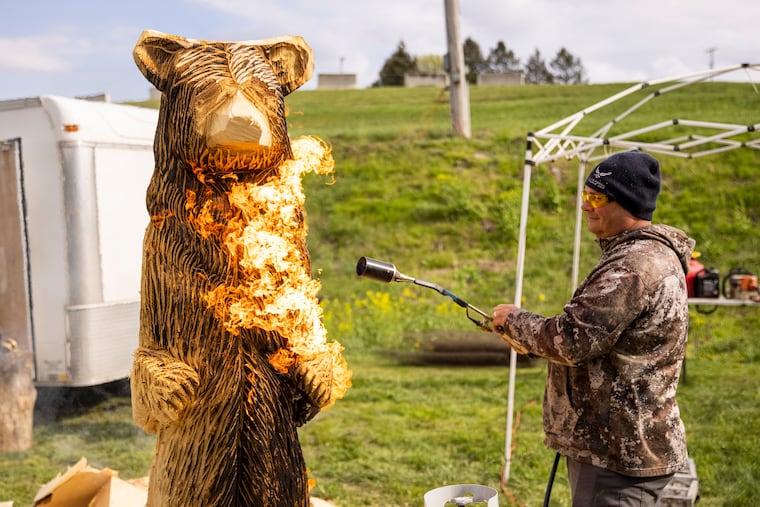A symphony of chainsaws comes to Central Pennsylvania
Over 60 chainsaw carvers descended upon Central Pa. last weekend to show off their skills.

SHIPPENSBURG, Pa. — One wood carver’s simple tools stood out among the hundred chainsaws buzzing like a hive of angry hornets.
Eric Baisas, 52, also had a few chainsaws — it was the inaugural Central PA Chainsaw Carvers Festival after all — but the toolbox of handheld chisels and mallets at his feet traveled more than 8,000 miles with him, from the Philippines to Virginia as a teenager, and here to a blustery field in the middle of Pennsylvania. Blowtorch smoke and sawdust whipped around in the wind, but Baisas was deeply focused on the winged woman emerging from a chunk of white pine.
“I think I’m calling her a butterfly lady,” Baisas said.
In the Philippines, Baisas said the wood of choice is mango. He and his carving partner, Angelito Baban, were both born and raised in the town of Paete, considered the “carving capital of the Philippines,” where every household, Baisas said, is filled with sculptures of saints and other religious iconography.
“We learned from our fathers and grandfathers and uncles,” Baisas said. “It’s everywhere there.”
» READ MORE: At 82, Pa. farrier still teaching students the ancient art of shoeing horses
While the three-day event last weekend was Shippensburg’s first, Pennsylvania has been home to numerous chainsaw and lumberjack festivals for decades, a reminder that “Penn’s Woods” is still one of the most-heavily forested states in the country. Pennsylvania was heavily logged during the 19th and early 20th centuries. While the chainsaw was invented in the 18th century to help with childbirth, of all things, modern, fuel-powered chainsaw carving took hold after World War II, with most of the carvers coming from a trade background, not art school.
“My background for this was starving carpenter who needed money when the housing market went down in 2008,” said Bill Schaudt, a chainsaw carver from Western Pennsylvania. “I started off carving pumpkins at a pumpkin patch for extra money.”
The bulk of the carvings on display in Shippensburg consisted of black bears, bald eagles, owls, wolves, and Bigfoot, with an assortment of other animals thrown in. Baban was carving a tall Native American man with an eagle perched on his arm. Some of the carved black bears — colored by paint or a blowtorch — held a “Welcome” sign. Others said “Go away.”
Carvings ranged from $50 for signs to several thousand for tall statue-like pieces.
“Bears are always a top seller, but Bigfoot is big around here,” Schaudt said.
Chainsaw carvers traveled from all over Pennsylvania, as well as Montana, Tennessee, and North Carolina. For many of them, the event was more of a social gathering than a chance to make money.
» READ MORE: Conshohocken sculptors find worldwide fame turning 1,000 pounds of butter into art
“I just thought it was something I could do as sort of a therapy,” said carver J.R. Miller, who operates heavy equipment in North Carolina.
Miller, 38, said his father was an alcoholic who was injured in a Virginia coal mining accident and later died in his sleep. His brother died from an opiate overdose shortly after.
“This is something to get lost in,” he said.
Dan “Danimal” Hartley traveled from Nashville with a truckload of carvings. On Friday afternoon, he was staring at a 3-foot-tall chunk of white pine for the festival’s speed competition.
“I’ve basically been working with wood for all of my life,” Hartley said. “I think I’m gonna make that owl. I see an owl in that woods.”
Scott Brown, president of the Shippensburg Chamber of Commerce, worked the admission table for the event and said the town of 5,663 in Cumberland and Franklin Counties was hoping for about 1,000 spectators. Drawing visitors to small-town Pennsylvania, he said, required creative thinking.
“We started reaching out to carvers and once you reach out to one, the word spreads,” Brown said. “We had over 60 here.”
» READ MORE: Pennsylvania’s post-industrial, public steps could use some love and attention
Unlike the bulk of bears and eagles on display, Baban had several hand-carved pieces for sale out front of his stall, including Jesus and the fishermen piece that was selling for over $1,000 and looked as if it took months to complete.
“I can do that in a week,” he said.
Baban, who works professionally with Baisas carving ice for the hotel industry in Virginia, said his house is “like a gallery.” At least one spectator wanted to see more, purchasing a balsa chariot sculpture from Baban for approximately $1,500.
“That’s not a chainsaw sculpture,” he said of the handmade piece.